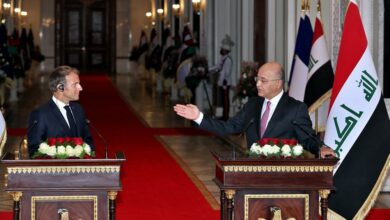As the world marks 10 years since the US invasion of Iraq, many will be thinking of that place again, perhaps for the first time in years. Discussions will be dominated by the use of the buzzword, ‘sectarianism’.
Most people wrongly perceive sectarianism to be a struggle inherent to Iraq, and not a political byproduct that serves the interests of a powerful few. It is important to understand that sectarianism in Iraq was exponentially magnified, first by Saddam Hussein’s regime and regional actors, then even more so by the political ethno-sectarian quota system written into Iraq’s 2005 constitution by occupying forces.
For many different reasons, few discussions will focus on the political struggles waged by the Iraqi people themselves, and the victories that they can claim as their own. These struggles are rooted in Iraq’s history of building movements that bring together different sects and ethnicities, and that take into account class differences, political affiliation, geography, gender and generation, to name a few.
Through these struggles, Iraqis will be able to transform their country from the bottom up.
Labor and stopping the Oil Law
Unions in Iraq have been organizing for workers’ rights, as well as broader political freedoms — often explicitly opposed to US presence — from the moment the occupation began. In January 2008, a broad coalition of Iraqi labor organizations called for the ratification of a new labor law that would sanction the right to organize, bargain and strike, and undo the 1987 law banning all public-sector unions, instituted by Saddam and upheld by Paul Bremer’s Coalition Provisional Authority. Several public demonstrations accompanied this call.
In December 2009, the Federation of Workers’ Councils and Unions in Iraq, as well as associated unions in the leather industry, concluded a 53-day strike — Iraq’s longest since 1931 — after having gained much-needed safety protections.
Perhaps the most resounding achievement of labor forces takes us back to September 2007. This was the deadline the US had set for the Iraqi parliament to pass the “Oil Law,” which was to institutionalize foreign corporate control over Iraq’s abundant hydrocarbon resources, mainly by removing Iraqi oversight.
The law was blocked because labor groups deeply understood the risk this law posed to Iraqi sovereignty, and mobilized a popular campaign starting in December 2006 to oppose the law, which eventually seeped into parliament and brought an end to the ratification process.
Presently, active contracts with companies such as Exxon exist without legal sanction, and the Iraqi parliament has yet to ratify a new labor law. The campaign for the right to organize, as well as to keep Iraq’s oil in Iraqi hands, sparked by the Iraqi Federation of Oil Unions around Basra, was a major blow to global and local interests, and a great source of pride and empowerment for many Iraqi activists.
Taking to Al-Mutanabbi and other streets
In response to the brutal occupation, its violence and the criminal levels of corruption it unleashed among local Iraqi politicians, Iraqis have also organized several large street demonstrations since 2003. Given the extreme lack of security, particularly between 2005 and 2009, it is remarkable that these protests existed at all.
On 25 February 2011, inspired by the uprisings across the Arab world, the “Iraqi Day of Rage,” a weekly Friday protest cycle, began in many of Iraq’s major cities. The demands were diverse, ranging from addressing chronically high unemployment and lack of services like electricity, to opposing the entire US-installed sectarian regime and occupation.
Leaders such as the Zaidi brothers — Uday, Thurgham and Muntazar, the latter of whom famously threw a shoe at former US President George W. Bush — began to emerge, and other civil society leaders affiliated with labor and women’s groups became heavily involved. Several popular Iraqi protest Facebook pages appeared, and, by 25 April, gatherings that had taken the form of open-ended sit-ins sometimes reached the tens of thousands.
In the northern city of Mosul, protesters called for a general strike, which froze all commerce and even pushed the local governor, Atheel al-Nujaifi, to back the protests and support the defiance of a government-imposed curfew.
As the concrete results of the protests began to mount against Maliki’s regime, with many local politicians resigning, including two in Basra alone, protest squares became sites for politicized poetry and cultural performances, drawing on Iraq’s rich heritages.
The government tried to suppress the protests, firing tear gas as well as live ammunition, and setting up checkpoints, which forced many to walk for hours in scorching heat to what would otherwise be nearby squares. Security forces also banned pens, markers, posters and water bottles.
Political consolidation within Iraq’s ruling elite enabled Maliki to absorb dissenting local politicians in places such as Basra. This also contributed to the severity of the crackdown, leading to a lull in this type of organizing. Many of these protest formations, and much of the energy that animated them, were to emerge late last year, when another protest wave began.
Beyond the sectarian frame
In late December, protesters took to the street to oppose the Maliki government’s decision to imprison the bodyguards of Iraqi Finance Minister Rafi al-Issawi. Many perceived this to be motivated by sectarianism.
Demonstrations ensued in the western province of Ramadi. People were not defending the Iraqi minister, whom they perceived to be another member of a corrupt government, but were objecting to sectarianism itself.
What began then as a seemingly limited public reaction to this decree quickly broke out of its mold to encompass many of the initial demands of the 25 February movement. These included the release of political prisoners — especially the thousands of women detained — a call for more jobs and better services, and the removal of the Iraqi constitution.
In particular, people were opposed to a “terrorism” law used often by the Iraqi government to target protesters with accusations of ties to Al-Qaeda or Saddam’s Ba’ath Party.
By mid-January, the protests had spread to three other provinces: Anbar, Niniveh and Salah al-Din. Media attention finally came to the protesters, but in a language of sectarianism that pigeonholed the protests as driven by sectarian strife, without taking into account any of the social grievances that formed the basis of these large demonstrations.
None of the media coverage focused on the explicit anti-sectarian slogans, or the role of women in these movements.
The protests are now approaching their third consecutive month, and Iraqi unionist Falah Alwan’s late January analysis still rings true.
“This moment could be a crossroads for more than one possibility — all is open now. First, it is possible that these protests could transform into a broad social revolution that changes the political system and builds another.
“And a new sociopolitical model could develop, one that opposes the model imposed on, and advertised for, in the region. The development of the present movement could refresh the revolution in the region as a whole and will not be apart from it — especially if it spreads through progressive forces to the southern and Kurdish regions.”
What has now been realized is that the Iraqi regime is facing a broad mass of people who publicly reject its policies and boldly raise banners stating so. In other words, the people have intervened in a sphere that the authorities want to monopolize.
Ali Issa is based in New York City and is the national field organiser for War Resisters League. This article was originally published in http://shakomako.net, a digital magazine about everything Iraqi.




